Key takeaways:
- Phishing scams in crypto often exploit urgency and fear, making it crucial to pause and verify communications before acting.
- Recognizing subtle signs like incorrect sender email addresses and generic greetings can help identify phishing attempts early.
- Utilizing tools like password managers, two-factor authentication, and security software significantly enhances protection against phishing attacks.
- Personal experiences highlight the importance of skepticism and critical thinking in avoiding scams, reinforcing the need for continuous education on security practices.
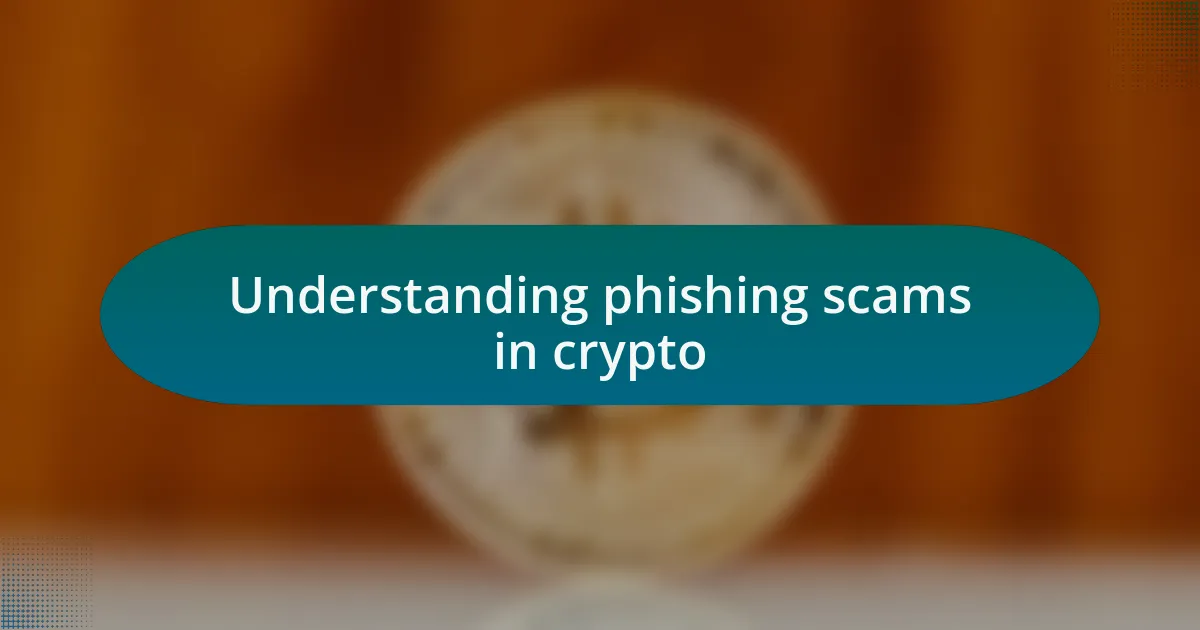
Understanding phishing scams in crypto
Phishing scams in the crypto space can be incredibly deceptive and often prey on our emotions. I remember the first time I received a message that seemed authentically from my crypto wallet provider, prompting me to “verify” my account details. It felt urgent and legitimate, but I hesitated and questioned, “What if this isn’t real?”
These scams usually involve fake websites or emails designed to trick users into revealing their sensitive information. There’s something unsettling about how easily these malicious actors replicate official communications. I recall reading about someone who lost a significant amount by clicking on a link without scrutiny; it made me wonder how many simply don’t take that extra moment to stop and think.
Understanding the psychology behind these attacks is critical. Phishing efforts often rely on urgency and fear, tapping into our instinct to act quickly. It’s surprising how a simple message filled with threats of account closure can cloud our judgment. I learned that pausing to verify the sender’s information and checking for red flags can make all the difference in protecting ourselves from these scams.
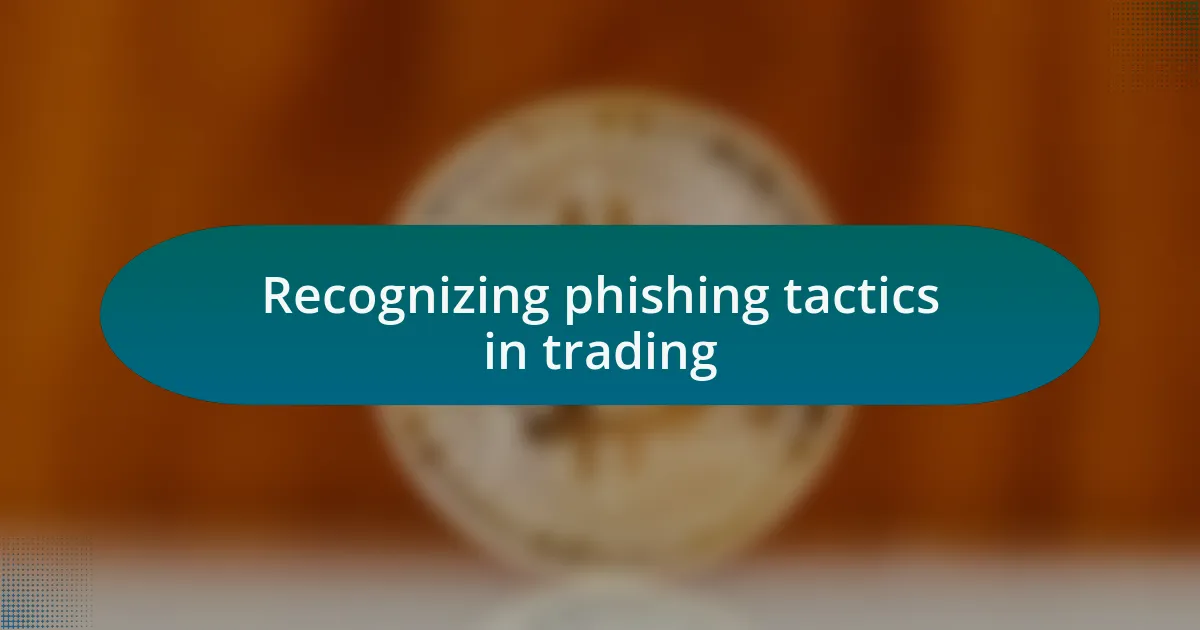
Recognizing phishing tactics in trading
When it comes to recognizing phishing tactics in trading, the first thing I always look for is the sender’s email address. I once received an email that appeared to be from a well-known exchange, but the address was slightly off—missing a letter or using a different domain. It made me realize how easy it can be to overlook those subtle signs in the heat of the moment, leading me to ask, “What else might I be missing?”
Another common tactic involves mimicking the website design of legitimate platforms. I remember visiting a site that looked so authentic, I nearly logged in before I caught the subtle differences in the URL. This experience taught me to always double-check that I’m on the official site, because a small mistake can lead to a significant loss. Isn’t it alarming how a mere oversight can lead us down a path fraught with risk?
Phishing scams often exploit our fears, creating a sense of urgency that pushes us to act without thinking. I’ve found myself in situations where messages create a false sense of impending doom, urging me to “act now or lose your funds.” In those moments, taking a breath and assessing the situation is essential. How many times have we rushed to click without considering if it’s truly necessary? I’ve learned that a moment of reflection can be my greatest shield against such schemes.
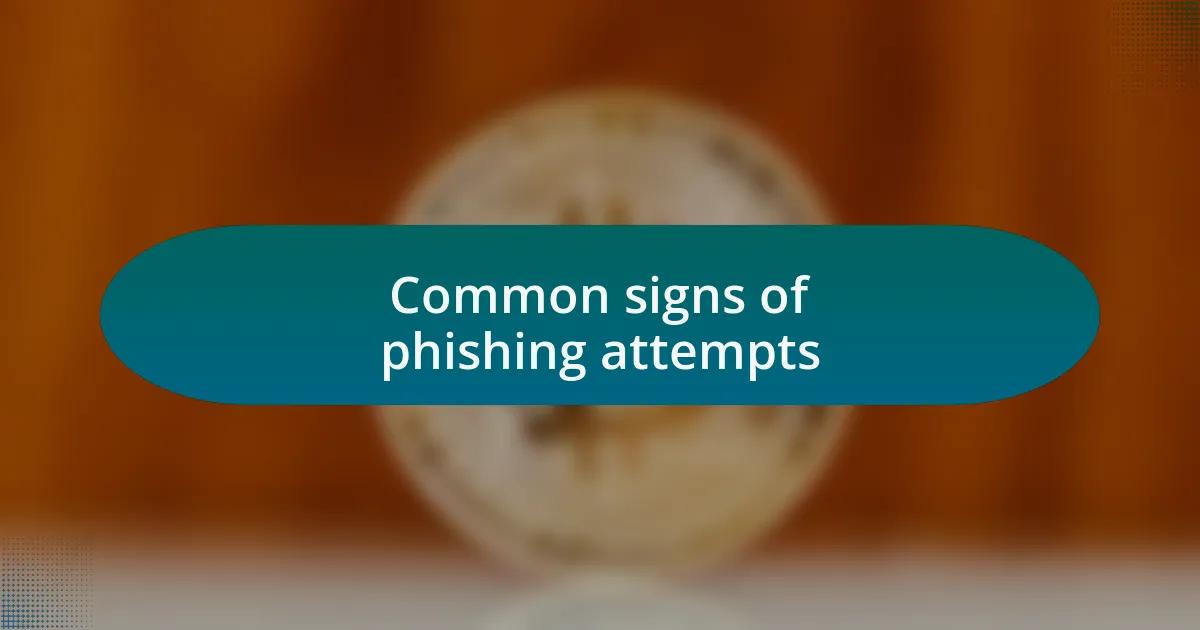
Common signs of phishing attempts
One of the telltale signs of a phishing attempt I’ve encountered is poor grammar or spelling in the messages. There was a time when I received a notification filled with typos and awkward phrasing, which raised my eyebrows immediately. It made me wonder, “Would a reputable company really send a message like that?” The answer was a resounding no, highlighting the importance of scrutinizing the message content.
Another red flag I’ve noticed is the use of generic greetings. I remember getting an email addressed to “Dear User” instead of my name. It felt impersonal and suspicious, as if they didn’t even know who I was. This instance made me realize that legitimate companies often personalize their communications. If you see generic language like this, it’s a strong indicator to pause and question its authenticity.
Lastly, links that lead somewhere unexpected can also be a significant warning sign. I once clicked on a link that promised a special offer, only to be directed to a strange, unrecognized website. It was a chilling moment, making me ask, “What if I had entered my credentials here?” This experience taught me the importance of hovering over links to preview the actual URL before clicking. It’s a simple step that can save you from falling into a potentially dangerous trap.
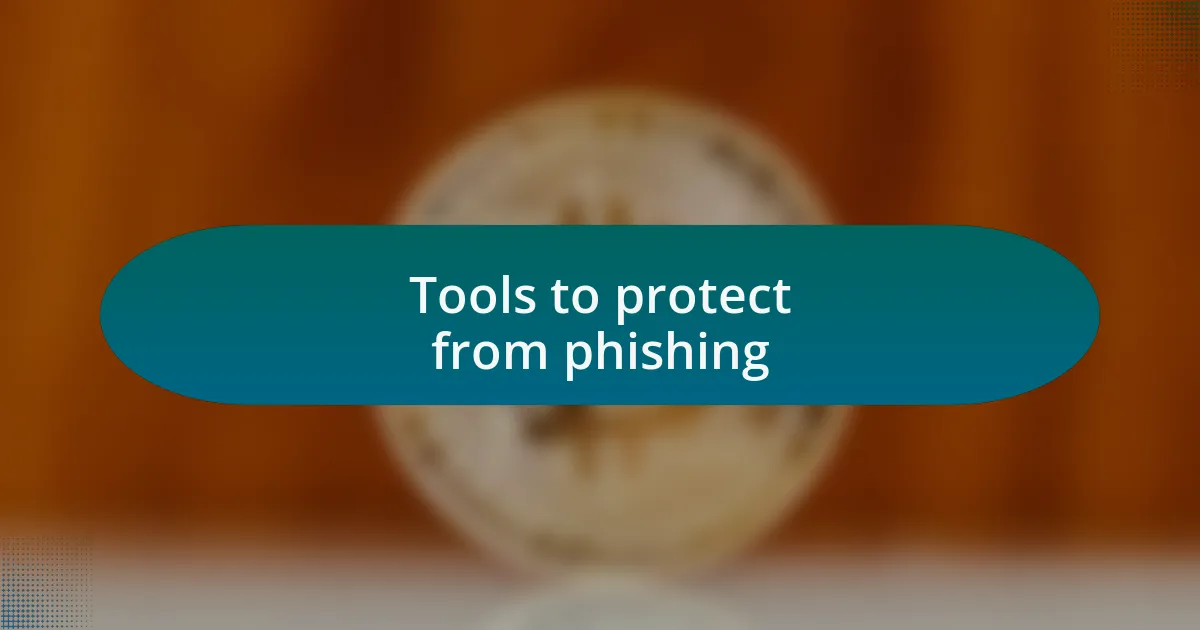
Tools to protect from phishing
When it comes to tools that shield you from phishing attacks, I’ve found password managers to be incredibly effective. In my early days of navigating online platforms, I often reused passwords, which felt convenient, but it was a risky habit. Since I started using a reputable password manager, I generate unique passwords for every site. This way, even if one site gets compromised, my other accounts remain secure. Have you experienced the relief of never having to remember those complex passwords again? It’s freeing.
Another essential tool I recommend is two-factor authentication (2FA). I could be working trade alerts when suddenly, a 2FA prompt pops up on my phone. At first, it was annoying, but I now understand its significance. It adds that extra layer of protection, ensuring that even if someone manages to steal my password, they still can’t access my account without that second verification step. Have you considered how implementing 2FA can serve as a safeguard against unauthorized access?
Lastly, security software is another indispensable tool I trust to combat phishing attempts. When I installed updated antivirus software on my laptop, I was amazed by how it proactively detected phishing websites before I even had a chance to visit them. It’s like having a vigilant guardian watching over my online activities. I remember a close call when I was about to enter my credentials on a spoofed site, and the software blocked it at the last moment. It made me think, “How many scams have I dodged thanks to this tool?” Having that kind of support makes a noticeable difference in my peace of mind when trading cryptocurrencies.
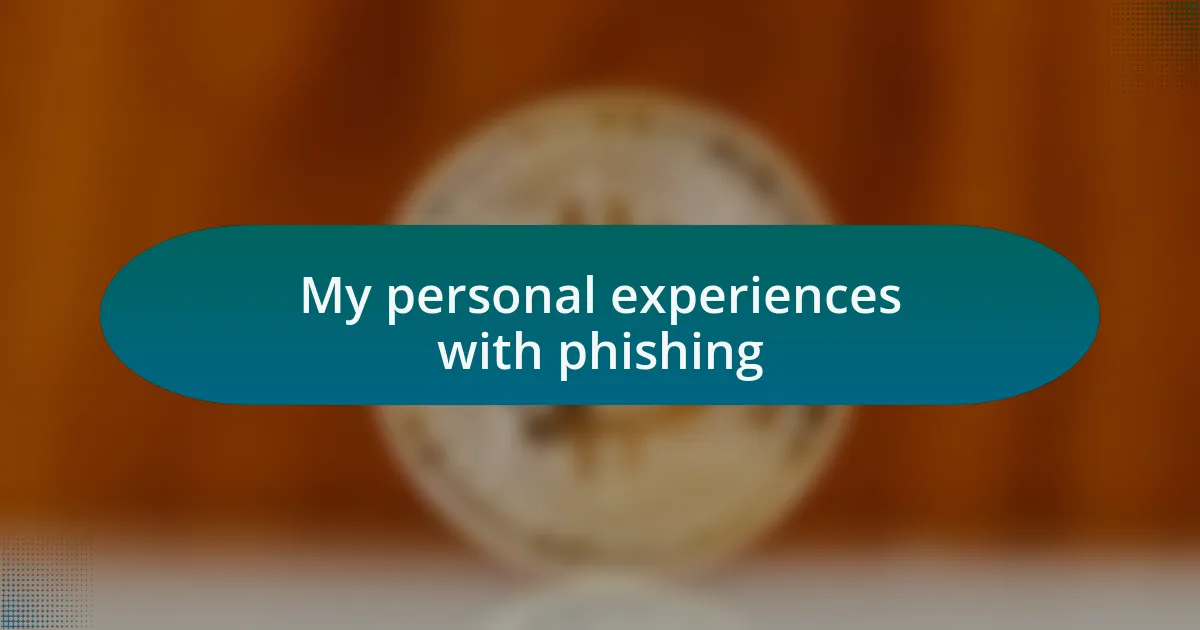
My personal experiences with phishing
Phishing scams have hit close to home for me. I remember when I received what seemed like an official email from a well-known exchange I used. It looked legitimate, complete with logos and formatting that mimicked their communication style. It took a moment of realizing the email address was slightly off for me to understand what was happening. That moment felt like a wake-up call; I asked myself, “How easily could I have fallen for that?”
Another experience that stands out was a pop-up ad on a crypto forum I frequented. It promised a free giveaway, all I had to do was enter my wallet details. My heart raced as my curiosity almost got the better of me. The lure of free crypto can be enticing—who wouldn’t want that? Thankfully, I paused, reflected on the risks, and opted to research instead. That decision reinforced my belief that skepticism is a valuable trait, especially in the crypto space.
Reflecting on these experiences, I realize they taught me to foster a critical eye. I’ve learned to ask probing questions before clicking links—questions like, “Does this seem too good to be true?” or “What’s the worst that could happen?” Each of these encounters has shaped my approach to security. It’s fascinating how such moments can turn into valuable lessons that empower us to stay vigilant.
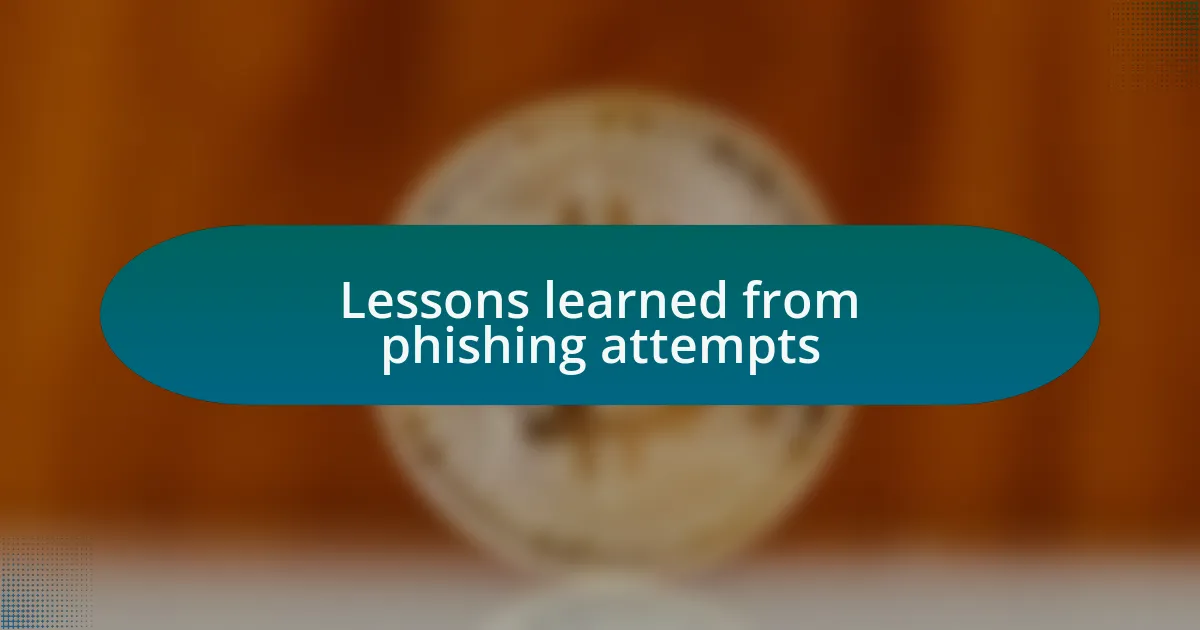
Lessons learned from phishing attempts
One critical lesson from my brushing with phishing scams is the importance of double-checking everything. I once received a message that claimed I needed to verify my account credentials immediately. My initial panic almost propelled me into action. But then I remembered my rules: I took a deep breath and scrutinized the sender’s email and links. What seemed urgent was often an illusion. Are we often too quick to trust what we see?
Another lesson I learned is that emotions can cloud judgment. I recall feeling a thrill when I encountered an unsolicited offer that seemed tailor-made for crypto enthusiasts. The excitement of potentially winning a prize nearly led me to surrender my information without a second thought. I had to remind myself that feeling excited or anxious often signals the need for caution. Now, I’ve trained myself to pause and evaluate these urges—what am I really risking here?
Ultimately, staying informed is my strongest defense against phishing tactics. I remember a time when I joined an online webinar about crypto security—it opened my eyes to the numerous techniques scammers employ. It struck me how much knowledge truly empowers our decisions. If I hadn’t invested that time in learning, would I have remained vulnerable? It’s a question that lingers with me and drives my commitment to continual education in this ever-evolving landscape.